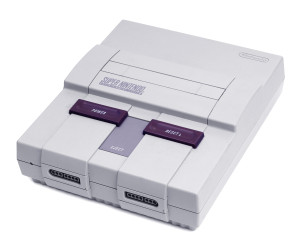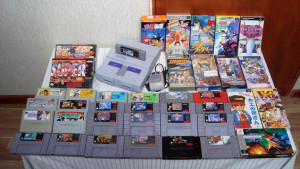The Coleco Chameleon Is Finished
The Coleco Chameleon has certainly lived up to its name, morphing from the Retro VGS into a licensed Coleco console, before transforming into a SNES Jr and then a capture card – but one gets ahead of one’s self. Lusipurr.com has previously covered the failure of the Retro VGS Indiegogo campaign [largely due to the console’s $300 price tag], and also the console’s transformation into the Coleco Chameleon in order to escape the stench of failure and mismanagement. The Coleco Chameleon team had to previously fend off fraud allegations when what appeared to be a prototype console was actually a translucent Jaguar shell containing a picture of a PCB board that was printed onto a piece of paper. However, when they were called out the team pointed out that it was only intended as a mock-up and that gamers would get to see a full working prototype at the 2016 North American International Toy Fair.
The 2016 North American International Toy Fair kicked off on the 26th of last month, and it certainly proved to be illuminating. Less than an hour after footage of the Coleco Chameleon ‘prototype’ console had been uploaded to the internet the Atariage forums had already concluded that it was actually the innards of a SNES Jr stuffed rather crudely into a Jaguar shell and then fastened together by electrical tape. SNES gamepads were hardwired into the front of the console casing where the USB ports were supposed to be housed. The power switch was inoperable because the SNES Jr was already switched on inside the Jaguar shell. The console was being powered by one of those generic classic console power supplies which have two plugs; one for SNES and one for Genesis. The back of the console housed exactly the same power and AV inputs as the SNES Jr, with everything spaced just as far apart and in the same dimensions. The console featured the same cartridge slot as the SNES Jr, and inserted into the slot was a cart which from the front looked like a Jaguar cart, yet from the back it was shaped as a SNES cartridge, and was later concluded to be a SD2SNES flash cart. Any one of these irregularities would be enough to cast deep suspicion on the Coleco Chameleon, but combined they made for a conclusive case. It was a SNES Jr, and obviously the only games that it was seen playing were SNES ones.
It is obvious that Mike Kennedy and the Coleco Chameleon team think that gamers are fools, as this is one of the most inconceivably shoddy attempts to fake a console that one can conceive of. When dealing with modern electronics the easiest control input that one could install is an off-the-shelf USB port, and the easiest way to export a game’s visuals would be to install an off-the-shelf HDMI port – and in fact this was the intended set-up for the Coleco Chameleon. In stark contrast to this we are somehow expected to believe that there could be a possible reason for a prototype model to use proprietary Nintendo control ports and AV ports. Nintendo component cables do not even export the same kind of RGB video signal as HDMI cables, so unless Mike Kennedy had Rube Goldberg on the design team then the console simply did not add up.
When this controversy broke one of the more common forum comments to appear were suggestions that if the team actually did have a working prototype, then they should show it off in a translucent casing so that detractors could see its inner workings and thus be assuaged. Funnily enough no sooner did these comments begin to appear than the Coleco Chameleon crew did just that, uploading a translucent Jaguar case containing a PCB board to Facebook, and announcing that the console’s proposed Kickstarter would be temporarily postponed in order to shore up developer support. This was very much a response to the doubters in the Atariage forums:
“There has also been a whirlwind of interest, speculation and curiosity regarding the insides of the Chameleon. We are delighted by this and happy to confirm that we will be releasing photographs of the system now on our Facebook page, and we’ll focus on turning our prototype into a production-ready product.”
This looked a lot more convincing than what was shown off at the toy fair, but then a more convincing prototype does nothing to dispel the irregularities that were in evidence with the previous model, and so the Atariage forums kept digging. A couple of days later on the 29th it was revealed on the forums that this ‘prototype’ was indeed another fake, as the PCB board seen through the translucent casing turned out to be a DVR capture card. Many electrical goods contain such boards, but in most cases the goods in question are never opened up and documented, so there is very little visual reference material available on the internet. Instead of pilfering a board from an old microwave though, the masterminds at Coleco Chameleon decided to use an off the shelf PC card: a consumer product where the board itself is the product, and thus there were tons of visual reference materials available to anyone who knew the right ballpark to be looking in.
If you are going to be dishonest then at least be good at it! Mike Kennedy has been caught in lie after lie after lie, and now the man’s reputation accounts for precisely nothing. If Kennedy wants to bring the Coleco Chameleon to market then he best be able to bankroll it himself, as a successful Kickstarter is beginning to look a little far fetched at this point.
New 3DS Gets New Exclusive Software!
Remember the New 3DS? It is still a thing, right? New 3DS was the handheld that Nintendo just had to release as its more powerful hardware allowed it to play demanding games that otherwise would have been impossible on the regular 3DS, such as Xenoblade Chronicles and… SNES ROMs? That is right, this week sees Nintendo finally releasing Super Nintendo Virtual Console titles for the New 3DS, but not for the regular 3DS, as the regular 3DS is simply not powerful enough to emulate a system which runs on a beefy 3MHz processor like the SNES! Never mind that jailbroken vanilla 3DS’ are able to emulate Super Nintendo games just fine – for free!
It gets even better, as Nintendo’s stated reason for only releasing the games to the newer console is because only the New 3DS has the power to display these SNES ROMs in Perfect Pixel mode (TM) – So essentially Nintendo not only has contempt for their vanilla 3DS audience, but they think that consumers on the whole are barely sentient drones in the bargain! The screens of both the 3DS and New 3DS are 400 x 240 when not in 3D mode, a resolution that is far from optimal relative to the processing power available to the 3DS, and was essentially the trade-off Nintendo made to fit the console with a pixel doubling 3D screen. SNES games are 320 x 240, a resolution which easily suits all models of the 3DS – and so Nintendo expects us to believe that the vanilla 3DS hardware is not powerful enough to display a 240p image! Fuck off. At least when Sega made claims of ‘blast processing’ the term actually meant something. Nintendo just makes up lies.
Gosh, Mr Nintendo – one is terribly sorry for only purchasing the 3DS and later the 3DS XL, so please arbitrarily withhold content from one’s pleb console, as it is only fitting that second-tier owners like this author should enjoy second-tier experiences! This is just another example of why Nintendo is a shitty company that gamers should not buy into. The New 3DS has not been useful for fuck-all ever since its release, so Nintendo obviously felt like they had to throw owners a few crumbs on account of it being a system which only exists because greedy Nintendo wanted a new model of the hardware to push! Thus they lock regular 3DS owners out of content that could easily be run on their system, marking them as second-class customers in the process.
Personally, one sees very little point in buying into an incomplete Virtual Console library which is tied to a device, and will not carry over to future Nintendo hardware. What point is there in a SNES library that does not include Final Fantasy VI and Chrono Trigger? Nintendo has not been able to offer a robust Virtual Console library since the Wii, and frankly all models of the 3DS are living on borrowed time at present, so it seems extremely unlikely that the New 3DS will gain access to much of a SNES library – thus one does not view this as a massive blow. That being said, this instance is nonetheless useful in demonstrating what an awful and niggardly company Nintendo is.
Nintendo News Round-Up
Speaking of awful company, Nintendo Treehouse’s Erik Peterson resigned this week. There is no news yet on whether he is one of Nintendo’s resident pedophile supporters like Alison Rapp, but he certainly seems to be a dirty big SJW. It is probably a little premature to celebrate his departure given that HR is likely to just fill his shoes with another SocJus thrall, and Peterson himself is likely to shit-up whatever company he goes to next – nonetheless change does have to begin somewhere.
In the case of Shin Megami Tensei x Fire Emblem change begins with the name, which is to say that the game has been renamed to Tokyo Mirage Sessions #FE. Upon seeing the hashtag in the game’s name one initially thought it was more of Nintendo Treehouse’s ‘quirky’ handiwork, yet the hashtag is present in the Japanese title too, so the cancer that is Treehouse must be spreading like a contagion throughout the rest of the company.
One change that does have Nintendo Treehouse’s finger prints all over it however is the decision to censor the game. Very little is known about the game at present, and so many more censorship changes will likely become apparent in the coming months, but just watching the game’s first English trailer is enough to reveal that main characters have been altered in order to erase even the faintest hints of cleavage. Given the healthy appreciation for sexuality which pervades the Persona series, it is extremely disappointing that Treehouse has been able to pervert this particular title. Tokyo Mirage Sessions #FE is a game which focuses to a large extent on Japanese idol culture, and yet Nintendo Treehouse have decreed that all woman must cover up – these two things are at odds, and the game’s immersion will likely suffer as a result.
The only part of Atlus’ original vision which looks to have survived intact is the games’ Japanese voice acting – not out of appreciation for the title’s native voice acting, but likely because Treehouse were not willing to allocate the budget required for English voice overs. Tokyo Mirage Sessions #FE has been given the Western release date of June 24, but one honestly does not know whether it is worth making the mental accommodations necessary to play it. If the Wii U jailbreak community decide to translate the uncensored Japanese original, then it might be better to simply install custom firmware and download the patched ISO.
Finally, Nintendo this week announced that Dragon Quest VII has been delayed from a Summer release into late 2016 so that Nintendo Treehouse can have more time to just fuck its shit up. This week’s Nintendo Direct listed the game’s complete re-translation as a bullet point in its favour, stating that the new translation makes it a completely different game – which is obviously the reason that Treehouse were given extra time to polish up their dialogue memes.
Anime Spotlight: Divine Gate
When the divine gate opened it ushered in an era of chaos upon the world, while connecting the heavens to the underworld in the process. To combat this the World Council was formed, and in the ensuing peace that it established the existence of the divine gate passed into legend. However, the Council continues to recruit children who exhibit potential, in the belief that those who reach the divine gate will be able to remake the world. When Aoto, a water adapter, is able to save a young girl from a fire adapter, both Akane and Madori are sent by the World Council to recruit him – yet Aoto is initially not too keen about joining up with the Council.
Divine Gate is not actually based on a manga, but rather an iOS and Android game – probably of the visual novel persuasion. One has not had time to watch Divine Gate on account of a recent Kill la Kill addiction, but the premise sure sounds interesting. The series began its run on the 8th of January, and there are currently nine episodes available. It is simulcast on Fridays at 9:30am Eastern on Funimation.



